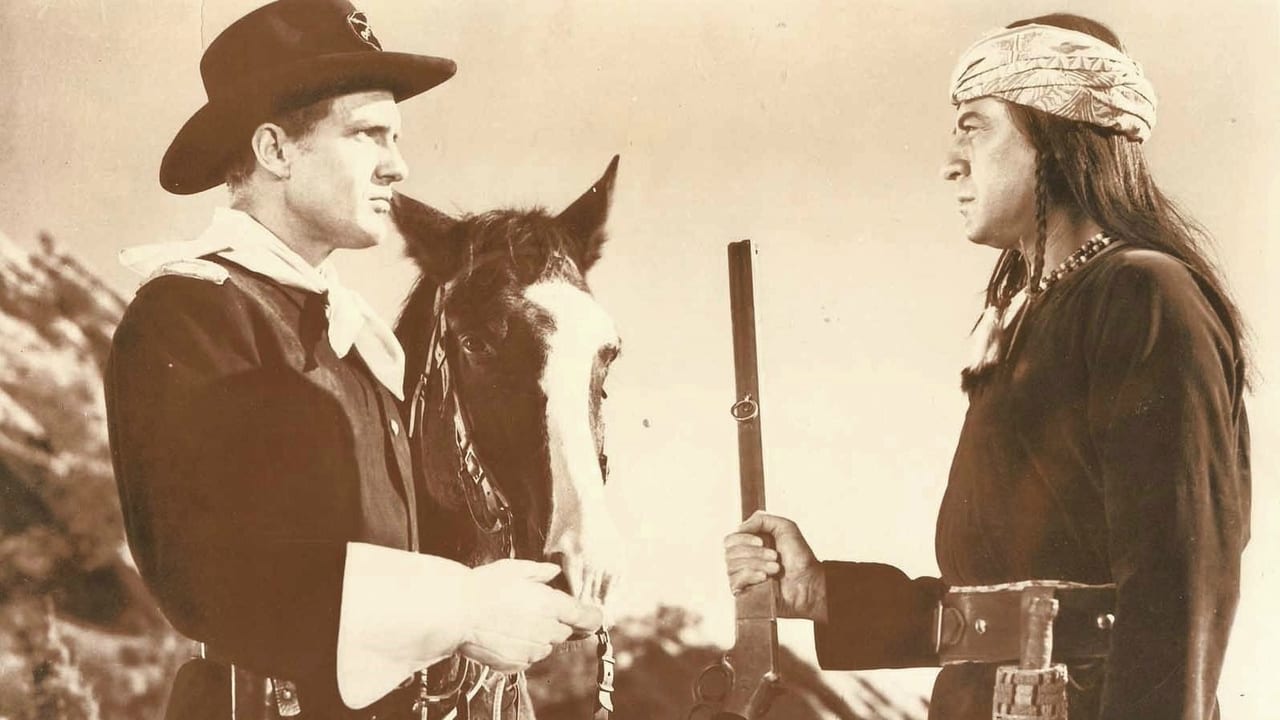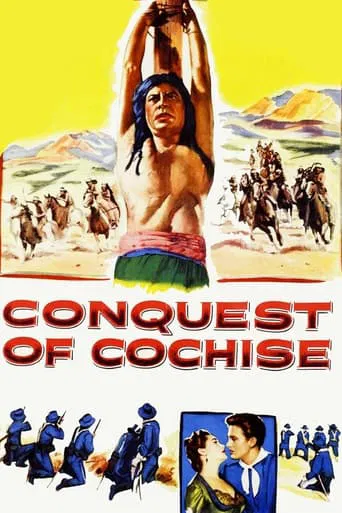

"Conquest of Cochise" is another low budget but competent little 70 minute western from the team of producer Sam Katzman and director William Castle. shot in glorious technicolor, it provides spectacular scenery under which the story unfolds.A piece of Mexican territory containing Tucson is sold by Mexico to the U.S. in 1853. Army Major Tom Burke (Robert Stack) is sent to the area to make peace with the Apache led by the notorious Cochise (John Hodiak). Burke, who has an eye for the ladies, takes an interest in the daughter of rich Mexican land owner Don Francisco De Cordova (Edward Coleman), Consuelo (Joy Page).Cochise is in favor of peace with the whites but his co-chief Takiwah (Steven Ritch) favors war with the white eye. Slick townsman Sam Maddock (Robert Griffen) who deals in arms, wants to keep the hostilities going. Consuelo's cousin Felipe (Rico Alaniz) whose wife was killed by the Apache, tries to kill Cochise when he comes for peace talks at Don Francisco's hosienda, but is stopped by Consuelo.Maddock supplies Felipe with a new repeating rifle. Still upset with the Apache, Felipe tries again to murder Cochise but kills his young wife by accident. Tukiwah again tries to convince Cochise to go to war bekieving that a soldier was the murderer. Cochise gives Burke four days to produce the real culprit. Meanwhile Cochise holds Consuelo hostage wher an attraction develops between her and Cochise.Cochise meanwhile, is having trouble keeping the Commanche under Chief Red Knife (Rodd Redwing) from going to war. Burke brings in Felipe as the killer with the understanding he will be tried by white man's law. Cochise again tries to make peace with the whites and the Commanche. However Red Knife takes Cochise prisoner and tortures him. Red Knife is about to put Cochise to the fire when.............................................................................................The movie, though it has an exciting finale, kind of drags in the middle. I was expecting that Cochise would have to fight Red Knife at some point or Burke vs. Red knife or Takiwah, but that didn't happen. Maddock's early demise was unexpected.This time Katzman and Castle had recognizable leads in Hodiak and Stack who perform competently. Joy Page makes a fetching pawn between the two leaders. Also in the cast are John Crawford as Capt. Lawson and real life Apache Charlie Stevens as one of the Apache chiefs.Just as an aside, the rifle shown appears to be a Winchester which didn"t come along until much later. As far as I know, the U.S. Army was still using single shot rifles at this time.
... View MoreI remain staggered when contemplating the inconsistency of William Castle's direction. My being boggled is seemingly rooted in Castle's implementation of two stylistic systems - malformed 'Twins' as it were. The Arnie isn't present in this outing. The "Devito" system is in full force with passive direction that features a tableau frontality dominant in the staging/blocking and camera positioning that succumbs to the idea that action should pass through it or track it in the most linear fashion. Like some of the Boston Blackie films, groups of characters are staged symmetrically creating an evenness like a Moe Howard bowl cut. Hackneyed quips and stilted performances abound. I believe the AFI archival notes on the film remark that the uniforms didn't fit historically. The stereotyping throughout Conquest of Cochise would fit adequately if you upped the action sequences in quantity and quality. The stereotyping could thus be rendered parodical cartoon or comic-strip homage, and vice-versa. The authorial voice of Castle is mute in this film and sequences are connected with sterile methodical execution. As such, the 4th Wall stands strong and the story is required to tell itself. The story itself is poor and the characterization does nothing to create spectator investment. Too much melodrama and not enough action renders a comic strip story into a tepid soap opera. Romantic subplots are developed as filler and not as focused torrid affairs. The talkiness is so overt that I have to wonder whether this churned out "B" historical Western was not produced solely to serve necking teens who needed a dark anonymous escape for a couple of hours. The ethnography of this film is bunk for a contemporary audience and perhaps outdated even at the time of its release. Were these Katzman-Castle history-drama productions simply gimmicks in service of a romantic subculture among audiences? I will admit that it would be easy to pay full attention to my lover's lips and blouse buttons with Conquest of Cochise playing - there would be no chance of a distraction.
... View MoreConquest of Cochise (1953)** (out of 4) Another Castle Western from Columbia certainly sticks to its "B" origins but there are a few interesting ideas that make it worth sitting through, although no one should expect a classic. Set in 1953 Arizona, Maj. Tom Burke (Robert Stack) wants to avoid a war between whites and Indians but a greedy Mexican wants both sides to fight and kill each other off. Indian Cochise (John Hodiak), on the other hand, wants peace but his people begin to pressure him into fighting this war. This film certainly doesn't have enough going for it to recommend to all people but I think those who enjoy "B" Westerns might find enough entertainment in its 70-minutes to make it worth watching. The film has way too much talk during the early parts but the final fifteen-minutes really pick up and end up packing a very strong punch. We start off when Cochise is sentenced to three tortures with one being bathed in hot steam and another impressive sequence where he's tied to a pole while the other Indians ride their horses up to him and slice him up with knives. This sequence doesn't contain anything too graphic but the editing and way it was directed makes it quite effective. We fall this up with a big battle scene that has the expected gunshots, bodies falling and of course the wild horse chases. Director Castle is best known for his horror films and most of them were in B&W but these early Westerns he did at Columbia gives you the chance to see him work in color and he certainly takes advantage of it. This movie looks like a coloring book because of all the vivid colors that are constantly on display. Whenever a set is on display it's got as many colors as they could possibly put in and this is a plus as there's always something to look at. Stack is pretty good in his role as I enjoyed the laid back approach he brought the character. It seems like the majority of the budget went to painting Hodiak red but he too is good in the role and gives it a certain passion that you can feel. The rest of the cast are pretty much what you'd expect in a film like this in terms of performances and character. Sam Katzman served as producer so that should pretty much tell you everything you'd need to know. Again, there's nothing overly special here but the final fifteen-minutes are well worth watching.
... View MoreI saw this movie when it was new, back in 1953, and the only thing I remembered about it was the final reel in which Cochise (John Hodiak) is sentenced to suffer three tortures: (1) scalded by hot steam, (2) sliced with knife blades, and (3) burned by fire. Many years later I saw the movie again and, what do you know?, the only thing worth remembering about it is that final reel. Robert Stack makes a serviceable, though undistinguished, hero, and the color photography has that "brightness" so common in early 1950's movies.
... View More